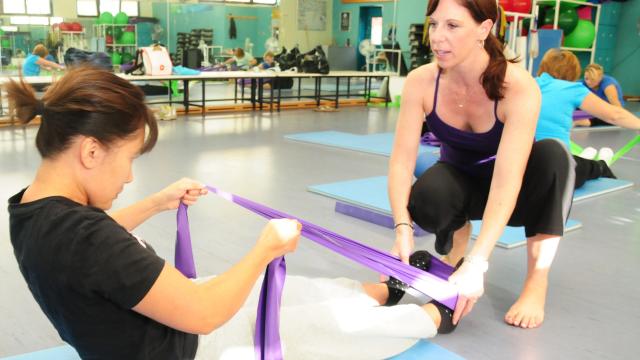The struggle to get a good workout when away from a gym (or your home) is real, but toss a few lightweight resistance bands in your go bag, and you can exercise anywhere.
Image by familymwr.
Sure, bodyweight workouts are an awesome option, but add resistance bands to mix, and you have a challenging workout without the gym. Bands come in a variety of colours that each represents a certain thickness, elasticity and tension, and thus makes it feel like you’re moving some serious weight. There are a few kinds, though I personally like the bands that are closed loops. They’re simply more versatile than the ones with handles, but both work fine and are compact.
Best of all, they’re affordable and are easier on the joints. Since resistance bands are essentially giant rubber bands, they’re very helpful for getting people past “sticky points” of an exercise that normally give them trouble, but still allow them to develop strength in other aspects of the movement (finishing a pull-up, for instance).
Here are some examples of exercises that resistance bands can enhance:
Pull-ups
For people who can’t yet do an unassisted pull-up, bands help lift you up from the bottom (the so-called “dead hang” portion), though once the tension eases up halfway through the movement you’re on your own for finishing the movement strong. To keep progressing, try either using bands with less resistance (so there’s less help at the bottom) or these non-banded exercises to help you toward a pull-up.
Push-Ups
This is an awesome way to make push-ups more challenging because the tension from the band makes it harder for you to finish the push-up at the top. Wrap the resistance band around your upper back and hold each end down with your hands as you get into the push-up position. If you can’t seem to get into position, the resistance is too “heavy”; go with something looser.
Suitcase Deadlifts
This banded version of the deadlift should be easier on the back, but still target your posterior chain (the muscles along your entire back side). Grasp the band on both ends and keep it anchored down by standing on it. When you deadlift (remember to hip hinge), you’ll notice the tension increasing at the top, but at the same time feel like you’re immediately getting pulled back down. Now that’s a challenge!
Bicep Curls
The bands can add extra challenge to both the rising and lowering portion of the bicep curl. Similar to setting up for the deadlift above, grasp both ends and anchor it down with your feet, then curl it like you’re trying to feed yourself an apple. If you want to make this movement extra spicy, emphasise slower movements.
Hip Thrusts
Hip thrusts primarily work the butt muscles and hamstrings. Securing the bands might be more difficult (but possible). Find super heavy objects, like one of bed frame legs, to anchor each side of the band.
Band Pull-Aparts
As the name suggests, the goal is to try to pull the bands apart while keeping chest and shoulders stable (and without arching your back). This exercise is helpful because we tend to overuse the front of our shoulders with push motions in general. So this hits the often weaker shoulder muscles in the back and keeps shoulders healthy.
Of course, there are many, many more exercises you can do with resistance bands. (Here are 33 of them from Greatist.)
You can also add these bands to weighted exercises, such as barbell deadlifts, squats and some presses.

Comments